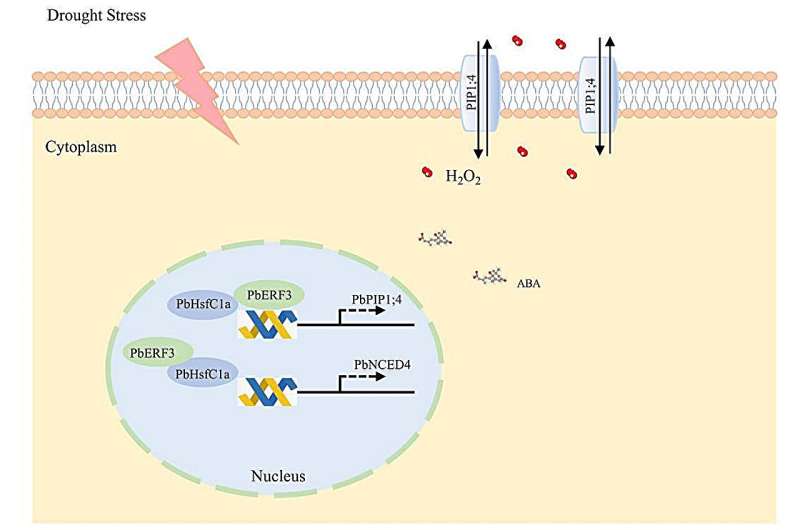
A model of PbERF3 interacting with PbHsfC1a activates PbNCED4 and PbPIP1;4 linked ABA and H2O2 signal to resistance to drought stress. Credit: TranSpread
A recent study has shed light on a critical genetic mechanism that boosts plants’ ability to withstand drought. The research uncovers the role of the transcription factor PbERF3, native to wild pears, which works in concert with the protein PbHsfC1a to regulate genes key to drought tolerance.
This breakthrough could significantly inform the cultivation of crops with superior resilience to water shortages, offering a vital solution to the pressing environmental demands of our time.
Drought significantly impacts agricultural productivity and plant survival. Traditional methods for improving drought resistance, such as selective breeding and genetic modification, have had limited success. Therefore, identifying genetic components that enhance drought tolerance is crucial.
Research has shown that understanding and manipulating these genetic factors can lead to the development of more resilient crops.
Due to these challenges, there is a pressing need to delve deeper into the genetic mechanisms of drought resistance to develop effective solutions for sustainable agriculture.
A team of scientists from the College of Horticulture at Nanjing Agricultural University published a study on March 30, 2024, in Horticulture Research.
The research focuses on the transcription factor PbERF3 from wild pear, demonstrating its role in enhancing drought resistance by interacting with another protein, PbHsfC1a. This interaction regulates the expression of genes involved in hydrogen peroxide transport and abscisic acid biosynthesis, critical for drought tolerance.
The study demonstrates that overexpressing PbERF3 in pear callus and Arabidopsis enhances drought resistance by restoring redox balance and activating key drought stress pathways.
PbERF3 interacts with PbHsfC1a, forming a heterodimer that binds to the promoters of PbPIP1;4 and PbNCED4, which are essential for hydrogen peroxide transport and abscisic acid biosynthesis.
This interaction activates critical signaling pathways that improve drought tolerance.
Silencing PbERF3 resulted in reduced drought resistance, underscoring its vital role in stress response. Additionally, the research shows that PbERF3 directly stimulates the transcription of PbPIP1;4, enhancing the plant’s ability to manage oxidative stress.
These findings reveal a novel regulatory module that plants use to combat drought stress, providing insights into developing genetically modified crops with improved drought resistance.
Dr. Xiaosan Huang, the corresponding author, said, “Our findings reveal a critical regulatory network that wild pears use to combat drought stress. Understanding this mechanism opens up new possibilities for engineering drought-resistant crops, which is vital in the face of increasing climate variability.”
This discovery provides a foundation for developing genetically-modified crops with enhanced drought tolerance, potentially improving agricultural resilience.
By leveraging the PbERF3-PbHsfC1a regulatory module, scientists can create plants better equipped to withstand drought conditions, ensuring food security and sustainable agricultural practices in arid regions.
More information:
Feng Zhang et al, Pyrus betulaefolia ERF3 interacts with HsfC1a to coordinately regulate aquaporin PIP1;4 and NCED4 for drought tolerance, Horticulture Research (2024). DOI: 10.1093/hr/uhae090
Provided by
TranSpread
Citation:
Pear-derived discovery: A genetic mechanism to fortify crops against drought (2024, July 5)
retrieved 5 July 2024
from https://phys.org/news/2024-07-pear-derived-discovery-genetic-mechanism.html
This document is subject to copyright. Apart from any fair dealing for the purpose of private study or research, no
part may be reproduced without the written permission. The content is provided for information purposes only.
>>> Read full article>>>
Copyright for syndicated content belongs to the linked Source : Phys.org – https://phys.org/news/2024-07-pear-derived-discovery-genetic-mechanism.html
